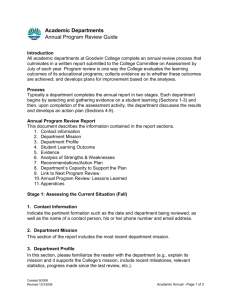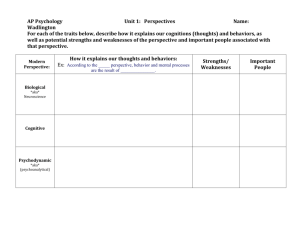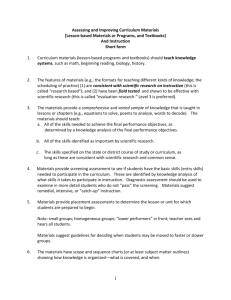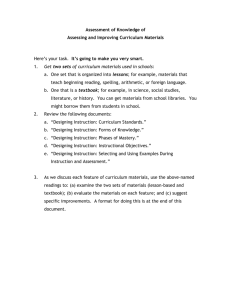Assessing and Improving Curriculum Materials and
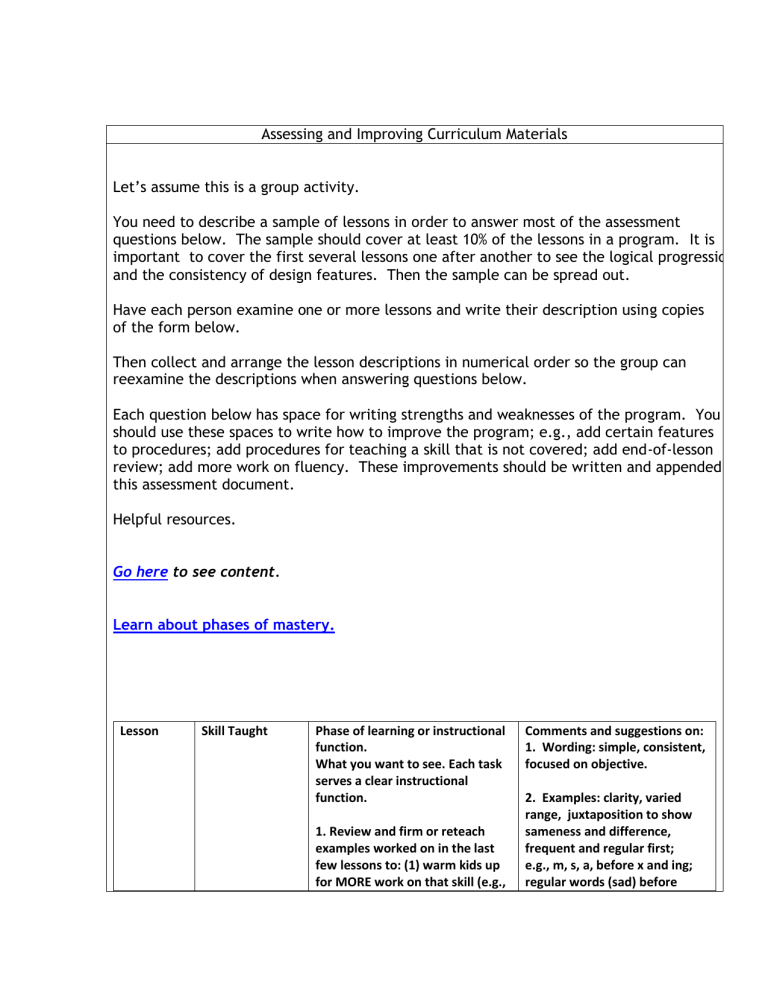
Assessing and Improving Curriculum Materials
Let’s assume this is a group activity.
You need to describe a sample of lessons in order to answer most of the assessment questions below. The sample should cover at least 10% of the lessons in a program. It is important to cover the first several lessons one after another to see the logical progression and the consistency of design features. Then the sample can be spread out.
Have each person examine one or more lessons and write their description using copies of the form below.
Then collect and arrange the lesson descriptions in numerical order so the group can reexamine the descriptions when answering questions below.
Each question below has space for writing strengths and weaknesses of the program. You should use these spaces to write how to improve the program; e.g., add certain features to procedures; add procedures for teaching a skill that is not covered; add end-of-lesson review; add more work on fluency. These improvements should be written and appended to this assessment document.
Helpful resources.
Go here to see content.
Learn about phases of mastery.
Lesson Skill Taught Phase of learning or instructional function.
What you want to see. Each task serves a clear instructional function.
1. Review and firm or reteach examples worked on in the last few lessons to: (1) warm kids up for MORE work on that skill (e.g.,
Comments and suggestions on:
1. Wording: simple, consistent, focused on objective.
2. Examples: clarity, varied range, juxtaposition to show sameness and difference, frequent and regular first; e.g., m, s, a, before x and ing; regular words (sad) before
more examples, new work on fluency or generalization), or (2) firm up elements that will be integrated into a larger whole (a, r, n -> ran).
2. Acquisition.
3. Generalization.
4. Fluency. All levels.
5. Retention: review and firm or reteach.
6. Expand; e.g., increase length of words or text.
7. Integration of elements into a larger whole. irregular worlds (said).
3. Scaffolding: pre-corrections
(“Remember to…”); attention checks (“What are you going to say?”); highlighting and other cues (arrows, pointing).
4. Elements of formats; e.g., explicit instruction during acquisition: gain attention, frame instruction (task, objective), model/present information (the first example in the acquisition set), lead, immediate acquisition test, error correction and/or verification, more models/examples from the acquisition set, delayed acquisition test (all examples from the acquisition)-> go on to next, firm, or reteach.
5. Elements (pre-skills) are taught early enough, and are reviewed/firmed continually before they are integrated into larger wholes that USE the elements.
6. Elements (e.g., say sounds, letter-sound correspondence, segmenting and blending) are integrated into larger wholes
(e.g., sounding out words, saying words fast).
1. Curriculum materials (lesson-based programs and textbooks) should teach knowledge systems , such as math, beginning reading, biology, history.
You should NOT use materials that teach faddish, unvalidated, or fashionable
“methods,” such as multiple intelligence, learning styles, and brain-based instruction.
Strengths, Weaknesses, Improve How?
2. Materials (especially programs) (1) are consistent with scientific research on instruction (this is called “research based”); and (2) have been field tested and shown to be effective with scientific research (this is called “evaluation research.” Level 3 is preferred).
Strengths, Weaknesses, Improve How?
3. Well-designed materials provide a comprehensive and varied sample of knowledge
(e.g., equations to solve, poems to analyze, words to decode).
The sample should be adequate to permit generalization to new examples.
You have three sources that will help you decide if the sample is comprehensive and varied. (1) state standard course of study, or curriculum; (2) scientific research; (3) expert opinion.
Strengths, Weaknesses, Improve How?
4. Well-designed curriculum materials have scope and sequence charts (or at least subject matter outlines) showing how knowledge is organized—what is covered, and when.
5. In well-designed materials, the lessons, units (sequences of lessons), or textbook chapters are built consistently from knowledge items selected from important strands
(groups of knowledge). For example, each lesson or unit includes new vocabulary, big ideas, important facts.
Strengths, Weaknesses, Improve How?
6. Well-designed materials, lessons, units (sequences of lessons), or textbook chapters
state and focus instruction on specific objectives — what students will do.
Strengths, Weaknesses, Improve How?
7. Well-designed materials teach knowledge items in a logical sequence. a. The materials teach elements or parts (necessary pre-skills and background knowledge) before teaching new material that requires skill with the parts. b. Pre-skills and background knowledge are taught early enough and continually, so that students are firm. c. What is more general and more frequent is taught before what is irregular or uncommon. d. Instruction on similar and confusing knowledge items is separated. e. What is more useful is taught before what is less useful. f. Complex skills (e.g., math routines) are taught with a sequence of procedures or formats from more to less scaffolded and from more to less teacher directed.
Strengths, Weaknesses, Improve How?
8. In well-designed materials, the lessons (math, writing, spelling, reading, or foreign language programs) or chapters (history or science textbooks) are a series of smaller,
knowledge-rich units (chunks), such as tasks, exercises, or paragraphs.
Each chunk serves a clear instructional function. a. Teach something new (facts, concepts, rules, cognitive routines). [acquisition] b. Summarize. c. Build fluency. d. Review and probes/tests (retention).
e. Expand---add more to existing facts, examples, concepts. f. Generalize knowledge to new examples. g. Strategically integrate---combine information into a larger whole, such as an explanatory essay, or a research project.
Strengths, Weaknesses, Improve How?
9. Well-designed materials (either lesson-based programs or textbooks) teach essential knowledge (e.g., pre-skills needed for future learning) in a systematic and explicit
(focused) way. a. Review and firm prior knowledge, or pre-skills. b. Regarding new knowledge, gain attention, frame new task, model, lead, test/check, verification; correct errors; more examples; delayed acquisition test. c. Review and firm what was just taught.
10. Well-designed curriculum materials adequately cover (teach, assess) all phases of mastery: acquisition (see #9), generalization, fluency, retention.
For each phase, there are stated objectives, instructional procedures, assessment of progress, and suggested remediation (if there is too little progress) based on assessment data.
Strengths, Weaknesses, Improve How?
11. Well-designed curriculum materials provide scaffolding; i.e., various kinds of assistance to help teachers communicate information, and to help students acquire, organize, retrieve, and apply information/knowledge.
Examples are stated objectives, highlighting, reminders and hints, wait time, big ideas,
advance organizers (lesson and unit outlines, guided notes, concept/proposition maps), summaries, glossaries.
Strengths, Weaknesses, Improve How?
12. Well-designed curriculum materials have periodic mastery tests or check-outs (e.g., every 10 lessons in a reading program; after every new skill in a math program) to assess acquisition, fluency, generalization, and retention. Materials also provide guidelines for deciding when students’ performance on assessment means that they (1) are firm and can move ahead; (2) need firming on certain knowledge; (3) need reteaching; or (4) need intensive instruction. Materials also provide plans and procedures for such remediation.
Strengths, Weaknesses, Improve How?

